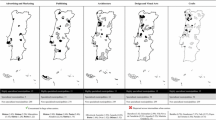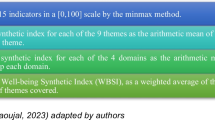Abstract
This paper addresses the performance of creative firms from the perspective of complex spatial systems. Based on an extensive high-dimensional database on both the attributes of individual creative firms in the Netherlands and a series of detailed regional facilitating and driving factors related, inter alia, to talent, innovation, skills, networks, accessibility and hardware, a new methodology called self-organizing mapping is applied to identify and explain in virtual topological space, the relative differences between these firms and their business performance in various regions. It turns out that there are significant differences in the spatial and functional profile of large firms vis-à-vis SMEs across distinct geographical areas in the country.
Article PDF
Similar content being viewed by others
Avoid common mistakes on your manuscript.
References
Acs, ZJ, Groot, HLF, Nijkamp, P (eds) (2002) The emergence of the knowledge economy. Springer, Berlin
Agarwal, P, Skupin, A (eds) (2007) Self-organizing maps: applications in geographic information science. Wiley, Chichester
Alecke B, Alsleben C, Scharr F, Untiedt G (2006) Are there really high-tech clusters? The geographic concentration of German manufacturing industries and its determinants. Ann Reg Sci 40: 19–42
Andersson A (1985) Creativity and regional development. Pap Reg Sci Assoc 56: 5–20
Arribas-Bel D, Nijkamp P, Scholten H (2011) Multidimensional urban sprawl in Europe: a self-organizing map approach. Comput Environ Urb Syst 35(4): 263–275
Bayliss D (2007) The rise of the creative city: culture and creativity in Copenhagen. Eur Plan Stud 15: 889–903
Bellini E, Ottaviano GIP, Pinelli D, Prarolo G (2008) Cultural diversity and economic performance: evidence from European Regions. In: Paper presented at the 7th European urban and regional studies conference ‘Diverse Europe: urban and regional openings, connections and exclusions’, Istanbul, 18–21 September 2008
Berry MMJ, Taggart JH (1996) Combining technology and corporate strategy in small high tech firms, strathclyde international business unit, Department of marketing. University of Strathclyde, Glasgow
Bommer M, Jalajas D (2002) The innovation work environment of high-tech SMEs in the USA and Canada. R D Manag 32(5): 379–386
Bruinsma FR, Kourtit K, Nijkamp P (2009) An agent-based decision support model for the development of e-services in the tourist sector. Research memorandum 2009–32. Faculteit der Economische Wetenschappen en Bedrijfskunde, Amsterdam
Capello R (2002) Entrepreneurship and spatial externalities: theory and measurement. Ann Reg Sci 36: 387–402
Caragliu A, Del Bo C, Kourtit K, Nijkamp P, Suzuki S (2011) A search for incredible cities by means of super-efficiency data envelopment analysis. Stud Reg Sci (forthcoming)
Charnes A, Cooper W, Rhodes E (1978) Measuring the efficiency of decision making units. Eur J Oper Res 2: 429–444
Cooper SY, Park JS (2008) The impact of ’Incubator’ organizations on opportunity recognition and technology innovation in new, entrepreneurial high-technology ventures. Int Small Bus J 26(1): 27–56
de Waal AA (2007) Strategic performance management, a managerial and behavioural approach. Palgrave MacMillan, London
de Waal AA, Kourtit K, Nijkamp P (2009) The relationship between the level of completeness of a strategic performance management system and perceived advantages and disadvantages. Int J Oper Prod Manag 29(12): 1242–1265
Duranton G, Puga D (2003) Micro-foundations of urban agglomeration economies, NBER Working Paper 9931. National Bureau of Economic Research Washington, DC
Felsenstein D (2002) Do high technology agglomerations encourage urban sprawl?. Ann Reg Sci 36(4): 663–682
Fischer MM (2001) Computational neural networks: tools for spatial data analysis. In: Fischer MM, Leung Y (eds) Geocomputational modelling: techniques and applications. Springer, Heidelberg, pp 79–102
Florida R (2002) The rise of the creative class. Basic Books, New York
Florida R (2003) Entrepreneurship, creativity and regional economic growth. In: Hart DM (eds) The emergency of entrepreneurship policy. Cambridge University Press, Cambridge, pp 15–43
Florida R (2004) The flight of the creative class. Basic Books, New York
Forte F, Fusco Girard L, Nijkamp P (2006) Smart policy, creative strategy and urban development. Stud Reg Sci 35(4): 947–963
Glaeser E (2004) Review of Richard Florida’s The Rise of the Creative Class, unpublished monograph, Harvard University, post.economics.harvard.edu/f aculty/glaeser/papers/Review_Florida.pdf
Jacobs J (1969) The economy of cities. Vintage, New York
Jones-Evans D, Klofsten M (1997) Universities and local economic development: the case of Linkoping. Eur Plan Stud 5(1): 77–94
Kohonen T (2001) Self-organizing maps. Springer, Berlin
Kourtit K, de Waal AA (2009) Strategic performance management in practice: advantages, disadvantages and reasons for use. Paper presented at the 2009 performance measurement association conference. University of Otago’s School of Business, Dunedin
Kourtit K, Nijkamp P (2011) Creativity and diversity: strategic performance management of high-tech SMEs in Dutch urban areas. In: Kourtit K, Nijkamp P, Stough RR (eds) Drivers of innovation, entrepreneurship and regional dynamics. Springer, Berlin, pp 45–64
Kourtit, K, Nijkamp, P, Stough, R (eds) (2011a) Drivers of innovation, entrepreneurship and regional dynamics. Springer, Berlin
Kourtit K, Nijkamp P, Arribas D (2011b) Smart cities perspective—a comparative European study by means of self-organizing maps. J Innov (forthcoming)
Kourtit K, Nijkamp P, Lowik S, van Vught F, Vulto P (2011c) From Islands of innovation to creative hotspots. J Reg Sci Policy Pract 3(3):145–161
Kohonen T, Honkela T (2007) Kohonen network. Scholarpedia 2(1): 1568
Krugman PR (1996) The self-organizing economy. Blackwell, Cambridge
Kumar M, Bowen WM, Kaufman M (2007) Urban spatial pattern as self-organizing system: an empirical evaluation of firm location decisions in Cleveland-Akron PMSA, Ohio. Ann Reg Sci 41(2): 297–314
Landry C (2000) The creative city: a toolkit for urban innovators. Earthscan, London
Lee SY, Florida R, Acs ZJ (2004) Creativity and entrepreneurship: a regional analysis of new firm formation. Reg Stud 38: 879–891
Lung Y (1988) Complexity and spatial dynamics modelling. From catastrophe theory to self-organizing process: a review of the literature. Ann Reg Sci 22(2): 81–111
Matheson B (2006) A culture of creativity: design education and the creative industries. J Manag Dev 25(1): 55–64
Mcgranahan M, Timothy W (2007) Recasting the creative class to examine growth processes in rural and urban countries. Reg Stud 41(2): 197–216
Moreno R, Paci R, Usai S (2005) Geographical and sectoral clusters of innovation in Europe. Ann Reg Sci 39(4): 715–739
Muñiz ASG, Raya AM, Carvajal CR (2010) Spanish and European innovation diffusion: a structural hole approach in the input-output field. Ann Reg Sci 44(1): 147–165
Nijkamp P (2008) XXQ factors for sustainable urban development: a systems economics view. Romanian J Reg Sci 2(1): 325–342
Nijkamp P (2009) Regional development as self-organized converging growth. In: Kochendörfer-Lucius G, Pleskovic BB (eds) Spatial disparities and development. The World Bank, Washington, pp 265–281
Nijkamp P, Suzuki S (2009) A generalized goals-achievement model in data envelopment analysis: an application to efficiency improvement in local government finance in Japan. Spatial Econ Anal 4(3): 249–274
Oakey RP (2007) Clustering and the R&D management of high-technology small firms in theory and practice. J R and Manag 37(3): 237–248
Olfert MR, Partridge MD (2011) Creating the cultural community: ethnic diversity versus agglomeration. Spatial Econ Anal 6(1): 25–55
Pavitt K (1990) What we know about the strategic management of technology. Calif Manag Rev Spring 17–26
Peck J (2005) Struggling with the creative class. Int J Urban Reg Res 29(4): 740–770
Porter ME (1990) Competitive advantage of nations. Macmillan, London and Basingstoke
Porter ME (2002) Regional foundations of competitiveness. Issues for wales. Paper presented at conference ‘Future competitiveness of wales: innovation, entrepreneurship and technology change’ on April 3, 2002
Reggiani, A, Nijkamp, P (eds) (2009) Complexity and spatial networks: in search of simplicity. Springer, Berlin
Shea C (2004) The road to riches? Boston Globe 29 Feb, D1. http://www.boston.com/news/globe/ideas/articles/2004/02/29/the_road_to_riches/
Skupin A, Agarwal P (2007) Introduction: what is a self-organizing map?. In: Agarwal P, Skupin A (eds) Self-organizing maps: applications in geographic information science. Wiley, Chichester, pp 9–21
Skupin A, Hagelman R (2005) Visualizing demographic trajectories with self-organizing maps. GeoInformatica 9(2): 159–179
Sonis M, Hewings GJD (1998) Economic complexity as network complication: multiregional input output structural path analysis. Ann Reg Sci 32: 407–436
Spielman S, Thill J (2008) Social area analysis, data mining, and GIS. Comput Environ Urban Syst 32(2): 110–122
Suzuki S, Nijkamp P (2011) A stepwise-projection data envelopment analysis for public transport operations in Japan. Lett Spatial Res Sci 4(2): 139–156
Suzuki S, Nijkamp P, Rietveld P, Pels E (2010) A distance friction minimization approach in data envelopment analysis: a comparative study on airport efficiency. Eur J Oper Res 207: 104–1115
Suzuki S, Nijkamp P, Rietveld P (2011) Regional efficiency improvement by means of data envelopment analysis through euclidean distance minimization including fixed input factors: an application to tourist regions in Italy. Pap Reg Sci 90(1): 67–89
Tornqvist G (1983) Creativity and the renewal of regional life. Lund Stud Geogr B Hum Geogr 50: 91–112
van Geenhuizen M (2007) Modeling dynamics of knowledge networks and local connectedness: a case study of urban high tech companies in the Netherlands. Ann Reg Sci 41(4): 813–833
van den Berg GJ (2001) Duration models: specification, identification, and multiple durations. In: Heckman JJ, Leamer E (eds) Handbook of econometrics, vol V. North-Holland, Amsterdam, pp 123–147
Yan J, Thill J (2009) Visual data mining in spatial interaction analysis with self-organizing maps. Environ Plan B Plan Des 36: 466–486
Open Access
This article is distributed under the terms of the Creative Commons Attribution Noncommercial License which permits any noncommercial use, distribution, and reproduction in any medium, provided the original author(s) and source are credited.
Author information
Authors and Affiliations
Corresponding author
Rights and permissions
Open Access This is an open access article distributed under the terms of the Creative Commons Attribution Noncommercial License (https://creativecommons.org/licenses/by-nc/2.0), which permits any noncommercial use, distribution, and reproduction in any medium, provided the original author(s) and source are credited.
About this article
Cite this article
Kourtit, K., Arribas-Bel, D. & Nijkamp, P. High performers in complex spatial systems: a self-organizing mapping approach with reference to The Netherlands. Ann Reg Sci 48, 501–527 (2012). https://doi.org/10.1007/s00168-011-0483-z
Received:
Accepted:
Published:
Issue Date:
DOI: https://doi.org/10.1007/s00168-011-0483-z




